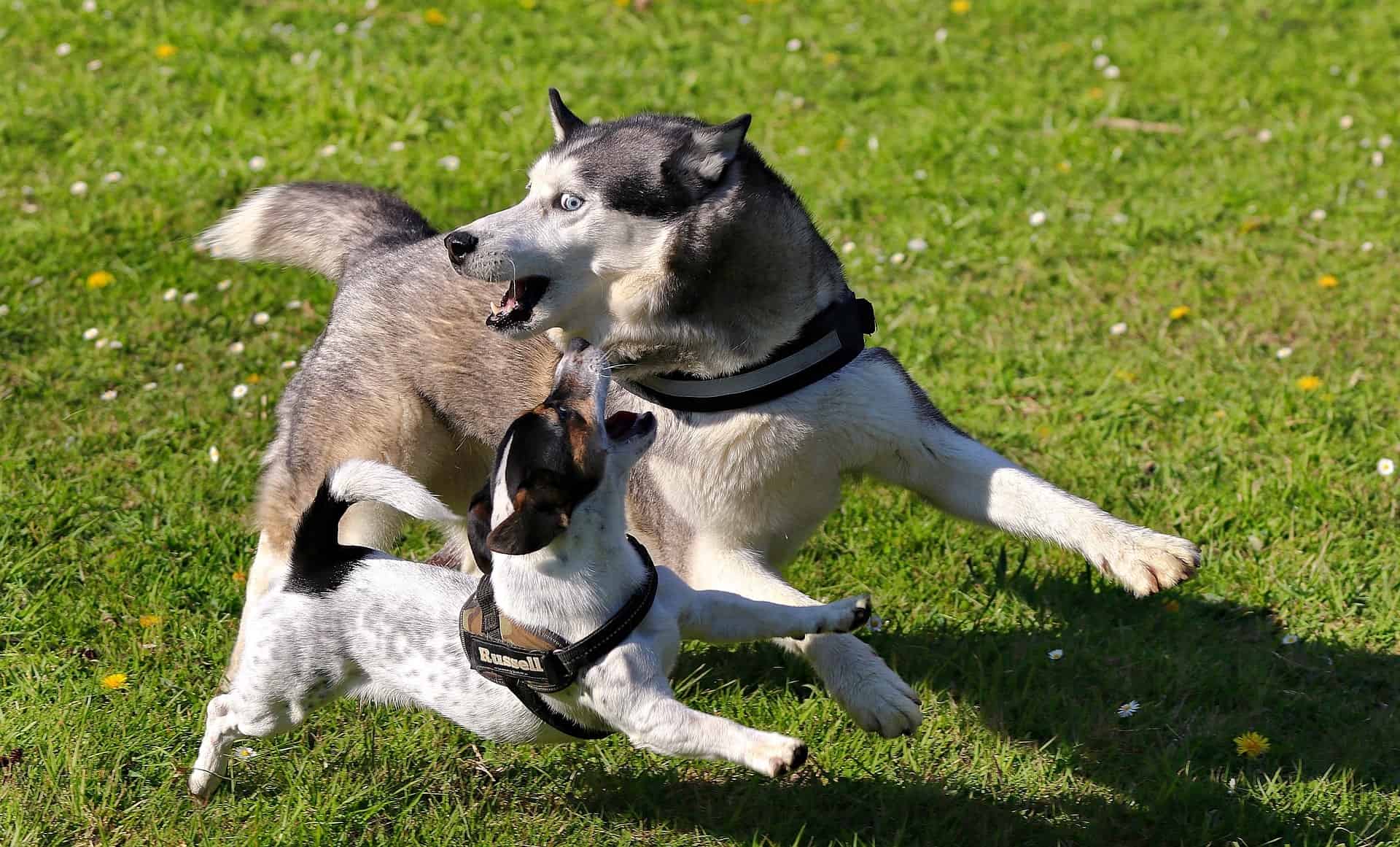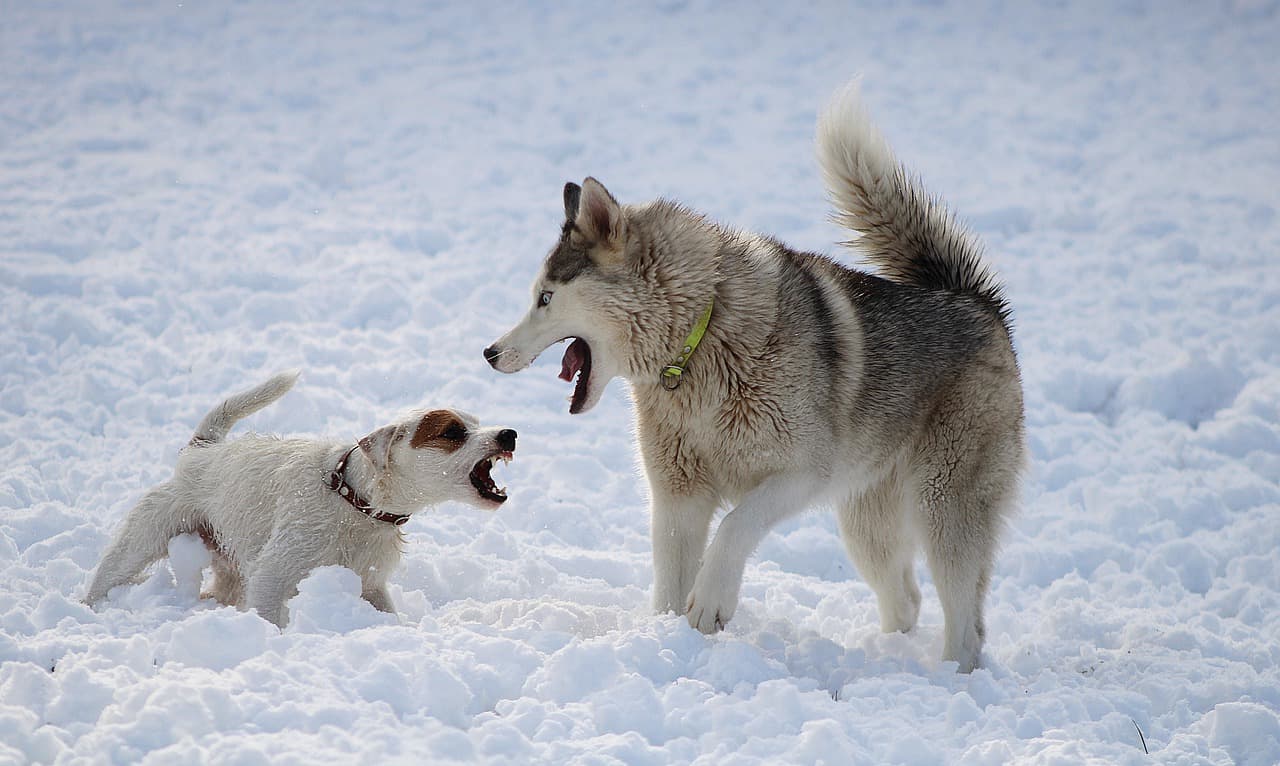If you’re a dog owner, you may have experienced your dog attacking another dog. This can be a scary experience, especially if the other dog is small. In this blog post, we’ll explore why dogs attack other dogs and offer some tips for reducing this behavior.
Remember that every dog is different, so what works for one dog may not work for another. If your Husky continues to attack other dogs even after trying these tips, consult with a professional trainer to help correct the behavior.
Why Is My Husky Attacking Smaller Dogs?
There are many possible reasons why a husky might attack a small dog, but one of the most common is fear.
When a Husky sees a small dog, it may mistake the pet for prey and act out in defense.
Whatever the reason, it’s essential to be aware of the potential danger that huskies pose to smaller pets and take precautions to keep both animals safe. Below we will go over the mean reasons why your Husky might attack smaller dogs and how to stop it.
Husky Fear Of Small Dogs
Huskies are generally friendly dogs, but they can be unpredictable around small dogs. Huskies are bred to be working dogs, and their instinct is to chase and capture smaller prey.
This instinct can override their training and socialization, leading them to attack small dogs. In addition, huskies are often not used to being around small animals, and they may view them as a threat.
As a result, it is essential to exercise caution when introducing a husky to a small dog. Huskies should always be supervised around small dogs, and owners should be prepared to intervene if necessary.
With proper management, however, huskies and small dogs can safely coexist.
Husky Need For Dominance Over Smaller Dogs
Huskies are naturally packing animals, and they may view small dogs as a threat to their position within the pack. In addition, huskies may also be territorial, especially if they perceive another dog as being on their turf.
While these behaviors can be alarming, it’s important to remember that they are usually just displays of dominance or territory marking and not actual aggression. With proper training and socialization, huskies can learn to coexist peacefully with other dogs, regardless of size.
Possessiveness May Trigger An Attack
One of the most common triggers for aggression in dogs is possessiveness over food or toys. This is often seen in small breeds, who may feel threatened by the presence of other larger animals nearby.
In some cases, this instinctual aggression can be directed towards people as well, particularly if the dog feels that its food or toys are being taken away. However, there are a number of things that owners can do to help reduce this behavior.
For example, feeding the dog in a separate room from other pets can help to reduce its sense of competition. Additionally, providing the dog with plenty of toys and chewable can help to satisfy its natural urge to chew and play.
Finally, by understanding the causes of aggression, owners can take steps to help prevent it from happening.
Husky High Energy Level May Lead To An Attack

It’s important to remember that Huskies are bred to be working dogs, and as a result, they often have high energy levels.
This can lead to frustration and aggression when they’re not given enough exercise, which can be a problem if you have a smaller dog in the house.
If you’re thinking of getting a Husky, make sure you’re prepared to give them the space and exercise they need. Otherwise, you might find yourself with an unhappy dog – and a big mess to clean up.
Too Little Socialization with Small Dogs
As any dog owner knows, it’s essential to socialize your pet from an early age. Well-socialized dogs are less likely to be anxious or aggressive around other dogs.
However, sometimes even the best-intentioned owners find themselves with a not well-socialized dog. If your Husky is attacking smaller dogs, it’s essential to take action.
The first step is to provide more opportunities for your husky to interact with other dogs. This can be done by taking him for walks in areas where there are lots of other dogs, signing up for doggy daycare, or attending obedience classes together.
It’s also important to avoid situations where your Husky is likely to feel threatened or uncomfortable.
Huskies Natural Protective Instinct
When a husky attacks smaller dogs, it is because it feels protective of its pack. Huskies are bred to be pack animals, and they naturally form close bonds with their family members. As a result, huskies typically view other dogs as potential threats to their pack.
When a husky perceives a small dog as a threat, it may respond by attacking the smaller dog to protect its pack. In some cases, this instinct may be so strong that the Husky will attack even if its family is not present.
While this instinct is natural for Huskies, it can be dangerous for both the Husky and the smaller dog involved. Therefore, it is crucial for Huskies to properly socialize with other dogs as early as possible.
How Can I Stop My Husky from Attacking Small Dogs?
If your Husky tends to attack small dogs, you can do a few things to help prevent this behavior.
1. Be Aware Of Your Husky’s Body Language
All dog owners know that it’s essential to be aware of their pet’s body language, as this can provide valuable insights into how they’re feeling. However, this is especially true for huskies owners, as these dogs are known for their high energy levels and sometimes aggressive behavior.
If you see your husky starting to show signs of aggression, such as growling or baring its teeth, it’s vital to take corrective action immediately. This may involve providing them with additional exercise, training them more extensively, or even consulting with a professional behaviorist.
2. Introduce Your Husky To Your Family
Huskies can get along very well with small dogs – but it’s essential to introduce them slowly and carefully. Small dogs are often intimidated by huskies’ size and energy, so it’s important to give them plenty of time to get used to each other.
Start by letting them sniff each other from a safe distance and gradually increase the amount of time they spend together.
3. Make Sure Your Husky Knows Basic Obedience Commands
When you take on the responsibility of training your new Siberian Husky, you must teach them with everyone in mind.
Training is best done as a family project, but one person should lead the way.
Too often, dogs only listen to one person, but the dog is practically untrained when they are not around. That’s why I always suggest making this type Of family project.
4 Make sure your Husky gets enough exercise and stimulation
Huskies need at least an hour of vigorous exercise every day, and they also benefit from mental stimulation in the form of puzzles, training, and playtime.
If you can’t commit to giving your husky the time and attention they need, then another breed may be a better fit for you. But if you’re ready to give a Husky the active lifestyle they crave, you’ll be rewarded with a loyal, loving companion.
5. Leash training your husky
Leash training your husky can be a bit of a challenge, but it’s vital to do if you want to take them out on walks or runs with you.
The first thing you need to do is get them used to wearing a collar and leash. Start by putting the collar on for short periods, gradually increasing the amount of time they wear it.
Once they’re comfortable with the collar, attach the leash and let them walk around the house with it. Next, you’ll need to teach them to walk calmly by your side.
Start by walking with them in your backyard or another safe area where there aren’t many distractions. Then, if they start to pull ahead, stop and make them sit until they calm down.
Once they’re walking calmly by your side, you can start taking them for walks around your neighborhood. Always keep a close eye on them and be prepared to pull the leash if they begin to run off.
6 Reinforce Obedience
If you want a good pet and not just someone there for its fun, make sure your dog obeys every command. You must be able to call your husky whenever you need to.
Using the command’ sit at a distance’ is a great tool to use on your excited furry friend.
It can be easier to stop your Husky from moving if he is far off. However, if the dog sits at your command and allows you to approach, there are possibilities for either distracting him or getting back on lead again!
If you’re not 100% confident that your dog will listen to all of the commands, it’s best to keep them on their leads. You can use extra-long training leads, which allow 10-20 meter distances, so if they decide to hunt, you have plenty of time to hold them back.
Can a husky live with a small dog?
Yes, a husky can live with a small dog, but it’s essential to ensure that the two dogs get along well before introducing them. Huskies are notoriously friendly and outgoing, so they usually do well with other dogs.
However, they can also be very rowdy and high-energy, overwhelming for a small dog. If you’re considering adding a husky to your home, it’s crucial to get to know the dog and make sure that they are a good fit for your family.
Once you’ve done that, gradually introduce the husky to your small dog, starting with short periods together in a supervised setting. With a bit of patience and understanding, you should be able to have both of your dogs getting along in no time.
Start by having them smell each other through a door or fence and give each other plenty of positive reinforcement when they behave well around one another. If there are any problems, take things slowly and consult with your veterinarian or an animal behaviorist for help.
In the end, it’s important to remember that every dog is different and what works for one may not work for another. So just keep an open mind, be patient and have fun with your new furry friend!

